Isabella, Mary & Gune Atkinson
Isabella Atkinson
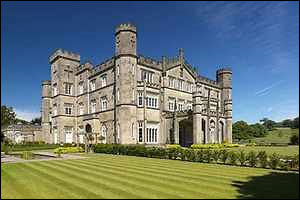 |
Isabella was born in 1850, the daughter of the Ironmaster of Stourbridge, William Orme Foster. They lived at Apley Park in Shropshire, with fabulous wealth and 17 servants.
When she was 31 Isabella married John Jepson Atkinson, who had inherited wealth from his uncle, of Hunslet Mills in Leeds. The wedding was in Knightsbridge, but there was no mention of any of Isabella’s family being present at the ceremony.
In 1882 William Henry Jepson St Leger was born to the couple. Both he and Isabella’s second son, Philip York, were named after racecourses. They had a daughter, Mary, born in 1885, who escaped this trend.
|
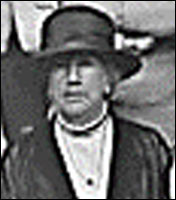 |
In 1886 Isabella and John Jepson bought Cosgrove Priory, and their son Philip born in 1887, and daughter Gune (1892) were born there.
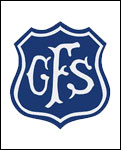 |
Isabella presided over village events and encouraged her two daughters to do the same. In 1901 she started a branch of the Girls’ Friendly Society at the Priory, encouraging young girls and women of Cosgrove to meet with wealthier girls and each other, to read, sew, sing, and enjoy simple refreshments. The benefits of this Society stayed with the village girls all their lives |
In 1915 Isabella’s eldest son St Leger was killed in the Great War. She threw herself into war work and fundraising, particularly for the Red Cross. This created a precedent in Cosgrove for other women to follow her example. She donated and presented prizes, as well as co-ordinating entertainment, where she played on her harp.
Isabella was one of the first women in Cosgrove to place her vote in 1919.
|
|
Mary Atkinson
| Mary was born in 1885 in Drayton, Oxfordshire, and came to live at the Priory in Cosgrove aged 2. She was brought up in the best Edwardian traditions of womanhood and is always described by people who met her as a “real lady”.
She rode side saddle always, and was the premier sister in the family, known all her life as “Miss Atkinson”, or “Mighty” to her younger sister. She received the vote in 1922 and attended Conservative Party meetings with her brother Philip, who inherited the Priory. She attended sporting events and played croquet for Northampton.
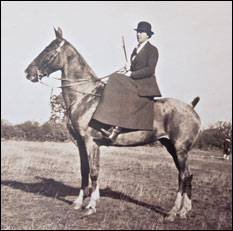
|
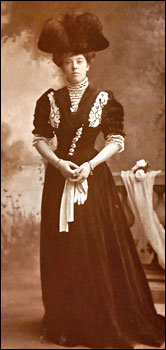 |
| After their mother’s death in 1930, Mary and Gune took Paulerspury House and lived together for the rest of their lives, continuing their mother’s example of good works and village leadership. Mary was president of Paulerspury Women’s Institute, and supported the Womens’ Voluntary Service and local hospital groups in WW2. In 1941 she was one of the first blood donors in the region. |
|
|
Mary was also a benefactor of the Church in both Paulerspury and Cosgrove, continuing to support fundraising events in both villages all her life.
She died in Paulerspury at the great age of 92, buried with her sister in the churchyard there.
Mary is commemorated on a plaque near the Chancel in Cosgrove Church.
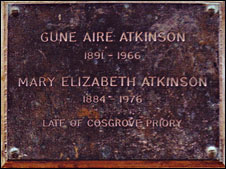
|
|
Gune Atkinson
Born in 1892, Gune was the baby, and tomboy, of the Atkinson family. Her second name, Aire, commemorates the river in Leeds, part of which her father once owned.
Gune was known as a “daring, high spirited person”, called “Kid” by her sister. She always rode astride, and is pictured here swimming in the River Tove with her brother Philip. She liked playing tennis, and would organise tournaments. She had a good singing voice, learned the piano at a music school in Northampton, and performed at local charity events. She played the organ at Cosgrove Church for significant services connected with her family.
|
|
|
|
|
|
Gune received her Red Cross certificate for Home Nursing, and later a Baden Powell certificate from the Girl Guides Association, enjoying their active, outdoor ethic. During WW2 she joined the Women’s Home Guard Auxiliary.
Gune had a well-developed sense of humour, and her comic appearances at dog shows, fetes and falling into water on Grafton Hunt outings were reported in the local press. She bred dogs with the Grafton Puppy Club. She was always referred to as “Miss Gune” in public, as the younger Atkinson sister.
Gune first received the vote in 1924, when she was 32 years old, and like her family actively supported the Conservative Party.
Although Gune served as a churchwarden for some years, it was reported in 1952 that she kept the Rector of Paulerspury in order, so her style was probably quite unusual for the time!
Gune died at Paulerspury at the age of 74, well before her older sister.
|
|

|